 |
|
|
 |
| |
[The entire month's notebook was edited on Jan. 30 to shorten it and speed up downloading.]
|
2005
January
29-31
|
Iced
 This morning [Jan. 29], all the pavement in town now has a centimeter of ice on it, and
people are being encouraged to stay home.
Most of the roads are barely usable, and there's more ice coming tonight.
Fortunately, there have not been extensive power outages.
This morning [Jan. 29], all the pavement in town now has a centimeter of ice on it, and
people are being encouraged to stay home.
Most of the roads are barely usable, and there's more ice coming tonight.
Fortunately, there have not been extensive power outages.
In the places that do have power outages, people are learning the
hard way that cell phones do not work by magic.
You think of a cell phone as something that talks to other cell phones by itself.
It doesn't.
It requires the services of one or more cell towers, and without them,
it's helpless.
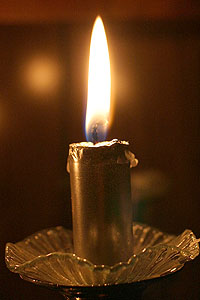 Candlelight:
At 8:10 p.m. our electricity failed, and a quick listen to the scanner radio told me
that ice-laden trees were falling on power lines all over town.
We settled in for the duration.
I'm writing a blog entry by candlelight, just like they did back in the 1800s
(just kidding!).
Actually I am using the laptop on battery power.
Candlelight:
At 8:10 p.m. our electricity failed, and a quick listen to the scanner radio told me
that ice-laden trees were falling on power lines all over town.
We settled in for the duration.
I'm writing a blog entry by candlelight, just like they did back in the 1800s
(just kidding!).
Actually I am using the laptop on battery power.
Melody's collection of candles has come in very handy.
One thing I was thinking about, while setting up candles, is that
odorless candles must be a modern convenience - they postdate the heyday of
candles altogether.
Paraffin wax is a byproduct of petroleum refining, so it wasn't common until perhaps
the 1920s.
Until then, candles were made of such things as tallow, which must have been smelly.
Both dogs went crazy at the sight of a flashlight in use.
They quickly decided that their job was to chase and capture the bright spot on
the floor.
Their frenzy was amazing.
When they started barking at candles, we decided we needed to supervise them closely.
And throughout the evening, we couldn't use flashlights with the dogs around,
except to herd the dogs!
One immediate discovery, when the power went off, is that
lead-acid batteries don't last forever.
The UPSes of three computers each ran for only a couple of minutes, not
long enough for me to shut the computers down properly
(though they have gotten us through a lot of momentary glitches).
The emergency light in our hallway didn't light at all.
Clearly, I need to replace a lot of batteries soon.
Would a gasoline-powered generator be handy? Well, it would certainly be
expensive, and we don't have power failures like this every year.
It would also be expensive to maintain because you have to change the
oil, start and run the engine, etc., every few months even if the generator
isn't needed.
Here's my idea.
If you need only a couple of hundred watts, the right solution is probably
a big inverter in an automobile.
The car engine is always ready to run
(out on the driveway, away from the house, of course).
We could connect a 250-watt inverter to it, run the line into the house, and
run a couple of lights and one or two essential appliances.
It's an expensive way to make electricity, but not an expensive way to have
backup power because, being purely electronic,
it costs nothing when you're not using it.
After 14 hours, after 10 a.m., the power finally came back on. It was a chilly night.
The scanner radio tells me power lines are still falling all over town!
I don't know whether the power is on to stay, but at least we can
warm up the house.
I'll close out the month's notebook now - since it's already too long to
download comfortably - and see you in February!

|
 |
2005
January
28
|
Tycho the Mystery Dog
 Now Cathy has a dog of her own, alongside Melody's dog Babbage,
and the two dogs are doing a marvelous job of entertaining and
even training each other.
Now Cathy has a dog of her own, alongside Melody's dog Babbage,
and the two dogs are doing a marvelous job of entertaining and
even training each other.
The way Babbage sees it, Tycho is his pet,
his personal responsibility to educate, supervise,
and even housebreak (!).
That is so even though Tycho is slightly the older of the two.
Tycho is a miniature pinscher
that falls slightly short of AKC breed standards,
so he isn't registered; he may have been sold off cheaply by his breeder,
we know not who or where.
From there, he had a misadventure.
In December, Tycho was found wandering along a road in Gwinnett County,
almost starved to death.
Since small, friendly dogs are normally taken in within a day or two of
reaching human habitation, we assume he starved for a while before getting out in the open.
Perhaps, for some tragic reason, his owner did not come home one day,
and nobody knew there was a dog in the house; then, after a while, Tycho
managed to escape.
He seems to have a knack for climbing gratings and fences; maybe that's what he had to do
to survive.
Once found, he was taken in by Pets To Be,
the rescue organization from which we got him.
Now he's ours and is very happy, especially with Babbage to take care of him.
By the way, we got the name Tycho from the 16th-century Danish astronomer, who in turn
got it from an early Christian writer also called Tychon or Tikhon.
Winter in the Sunny South
 So much for the warm weather of three weeks ago - now we're
under a winter storm warning.
So much for the warm weather of three weeks ago - now we're
under a winter storm warning.
Northerners constantly ask, "Why do you Southerners shut the whole city down every time it snows?"
The answer is that we don't get dry snow down here - we get ice storms.
You shut your cities down too, when you have ice storms.
For snow to be safe and innocuous, the temperature has to stay below freezing.
That's not what happens here.
Snow or rain will fall on objects just below freezing, then melt and freeze
several times, giving everything a treacherous coating.
If you invent something...
Several times recently I've been contacted by people with new inventions in my field
(artificial intelligence).
I don't mind hearing about inventions.
But please don't ask me to do your homework for you free of charge.
If you invent something, it's your job to find out how it relates to what is
already known in the field.
You can of course hire a consultant to do this for you if you need help.
But if you don't know the current state of knowledge, how do you know you have an
original idea?
Sir Isaac Newton talked about standing on the shoulders of giants.
I suppose some people prefer to stand in foxholes.
I should also mention the
big difference between inventing something and
wishing for it to be invented.
Unless you know how to make it work, you haven't invented it;
you're just wishing.

|
 |
2005
January
26-27
|
One of Lou Garner's transistors
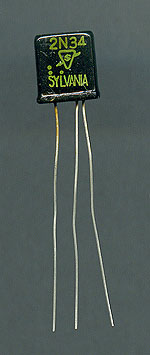 The unassuming object at the right is a 50-year-old transistor.
Specifically, it is a Sylvania type 2N34 germanium PNP transistor dating
from the mid-1950s.
But its main claim to fame is that it belonged to the late Louis E. Garner, Jr.,, who
for 20 years or more was semiconductor specialist for Popular Electronics.
I saw part of Garner's estate on eBay and made contact with the seller;
I'm going to help him identify gadgets.
The unassuming object at the right is a 50-year-old transistor.
Specifically, it is a Sylvania type 2N34 germanium PNP transistor dating
from the mid-1950s.
But its main claim to fame is that it belonged to the late Louis E. Garner, Jr.,, who
for 20 years or more was semiconductor specialist for Popular Electronics.
I saw part of Garner's estate on eBay and made contact with the seller;
I'm going to help him identify gadgets.
During elementary school, I learned quite a bit of electronics from
a book called Transistor Circuits, written by - you guessed it - Lou Garner.
It consisted of one circuit or project after another, maybe 200 in all,
each with an adequate but not longwinded explanation.
The book was published by Coyne Electrical School as a rather motley
collection of textbooks which were sold together as a 7-volume set;
my father found them in a pawn shop in Valdosta and snapped them up for me.
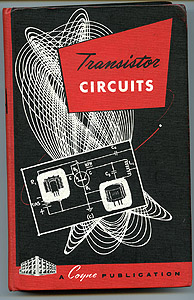
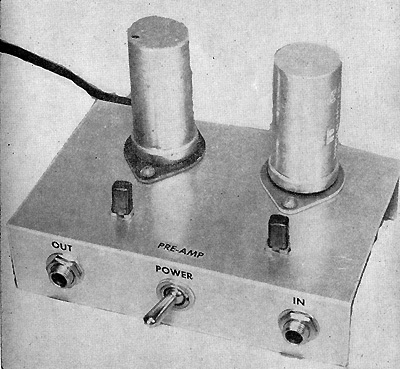
The second picture shows how Garner built transistorized equipment.
In those days, a transistor cost more than a vacuum tube (about $5 versus $1
in 1950s dollars), so it was accorded great respect, with a place of honor in a
socket on a metal chassis.
The enormous electrolytic capacitors at the back are for emitter bypass,
not power supply; that's what 300 microfarads looked like in those days.
One circuit in Garner's book has continued to intrigue me.
It's the oscillator shown below.
It works very well - and the teacher was impressed when, in sixth grade,
I built one on Vectorboard and brought it to school, demonstrating it by
making squealing noises in a speaker.
But it's hard to simulate this circuit; PSPICE wants to say it won't oscillate.
I hope to say more about this later.
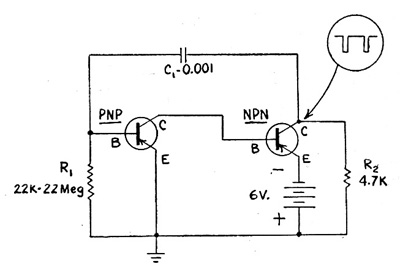

|
 |
2005
January
25
|
Showing the passage of time in a still picture
 Consider again yesterday's picture of how to open the battery pack.
This is in fact a mundane example of something the great art critic
E. H. Gombrich somewhere wrote about:
how to show the passage of time in a still picture.
Consider again yesterday's picture of how to open the battery pack.
This is in fact a mundane example of something the great art critic
E. H. Gombrich somewhere wrote about:
how to show the passage of time in a still picture.
Gombrich's example was a painting of Moses striking the rock, where
water is already flowing out even though Moses hasn't quite hit it yet.
Successive events are compressed into the same picture, and the viewer
is supposed to understand the sequence.
Mine is more mundane, but you see the battery pack opening even though
it's not clear that the tab has really been depressed all the way yet.
If this is a pictorial trick, it's an old one.
The Voynich manuscript, as I was saying,
is probably pure blarney, not a decipherable manuscript at all.
One of the first people to say this was
Gordon Rugg,
whose specialty is scientific mistakes.
Rugg points out that people got stuck trying to "decipher" the manuscript
because they couldn't stop thinking that if it's a manuscript, it must be decipherable.
This reminds me of continuing attempts to
identify the Biblical Star of Bethlehem
with a reconstructible astronomical phenomenon, even though the description sounds more like
a non-reconstructible nova or supernova.
If you can only "solve" a problem one way, you keep working on that kind of "solution" even if it's wrong.
I compared it to the drunkard looking for his keys under the lamppost
because that's where he can see, even though it's not where he dropped them.
Or, more succinctly, if your only tool is a hammer, then everything looks like a nail.
How much present-day scientific research is off-track in precisely this way?
Enjoy Yugo Nakamura's
hard-working digital clock!

|
 |
2004
January
24
|
How to soup up a Dremel
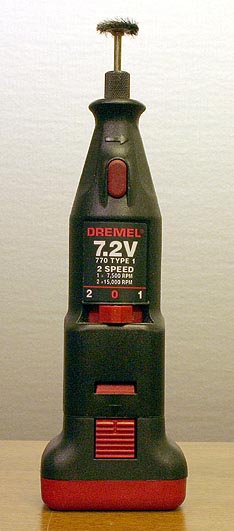 This afternoon I had some trouble with the batteries running down prematurely in my
rechargeable Dremel 770 rotary tool,
so I decided to check them out.
This afternoon I had some trouble with the batteries running down prematurely in my
rechargeable Dremel 770 rotary tool,
so I decided to check them out.
First the bad news: my 770 is the older model, and its battery pack,
the 757, is apparently no longer available.
But there's some good news too.
The battery packs can be opened up nondestructively to replace the cells in them.
The picture shows how: just depress each red tab
(at the opposite end than you normally depress it)
with the help of a screwdriver.

Inside you'll find two sets of three NiCd AA cells in series.
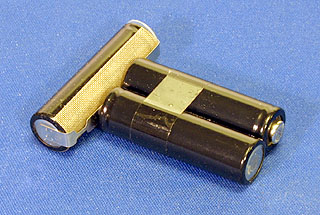
These are easy to replace.
The only catch is that you can't solder NiCd cells directly;
you can either have tabs spot-welded to them,
or buy cells with solder tabs already attached.
The latter is what I did, and actually, the new cells were already
on hand.
I had to clip the first and last tabs and turn them into
graceful (or at least servicable) lumps
by putting drops of solder on them.
You can have the spot-welding or the entire job done by any
Batteries Plus store;
they specialize in cutting battery packs open, replacing the cells,
and putting them back together.
For them, this is a particularly easy job.
I did it myself, and my only goal was to get everything working again,
so I used NiCd cells that were already on hand.
But I have a plan...
Instead of NiCd, I'm going to install NiMH cells that are available
at bargain prices from
All Electronics.
I've used these before, and they make fine replacements.
NiCd and NiMH cells have the same voltages
(so the Dremel will still run at the same speed)
but the NiMH cells have a lot more capacity
(1200 versus about 400 mAH),
so they'll take longer to charge in the same charger.
That, actually, is good.
Dremel's "3-hour charger" applies 200 mA, which is enough to damage NiCd cells
that are left in it too long.
With good NiMH cells, the charging period will be longer - maybe 8 or 9 hours -
but there won't be damage if the cells are left in for 24 hours or even longer.
I also plan to install Dremel's
adjustable chuck
so I won't have to keep hunting for collets.

|
 |
2005
January
23
|
Renaissance humbug?

Beinecke Library
One of the oddest things in the
Beinecke Library
of Yale University - where I myself have read some odd things, but not quite this odd -
is known as the Voynich manuscript.
It is written in no known language; contains astronomical diagrams and pictures of
plants (unidentifiable) and naked women; and seems to have originated in the 1500s.
You can see it in its entirety by going here
[Link corrected]
and typing "Voynich" in the search box.
All that is known about it is reviewed nicely in
Wikipedia,
an all-volunteer encyclopedia that is one of the best things on the Web.
It was also featured recently in
Scientific American
and in NASA's
Astronomy Picture of the Day.
It has been suggested that the language is Manchurian,
written in an invented script.
Manchurian was once a major language of China, unrelated to Chinese;
today it has practically died out.
This is a sobering reminder that many of the important world languages
of just a few hundred years ago have vanished.
You can occasionally see Manchurian writing
on signs in China; it looks like Arabic turned sideways.
More likely, though, in my opinion, the manuscript is pure blarney,
designed to be carried around by a quack physician to impress his clients,
or to be sold to a gullible purchaser.
One thing's for sure.
Much of the "superstition" that we attribute to the Middle Ages
actually flourished after the Middle Ages ended - if indeed they had a clear end at all.

|
 |
2005
January
22
|
BPL, shortwave radio, and freedom
The current chairman of the Federal Communications Commission
has resigned amid growing unpopularity.
One of the things he is most unpopular for is his advocacy
of BPL
(Broadband over Power Lines), a system of Internet access
through radio waves sent over existing electric power lines.
BPL will do two things.
It will make Internet access cheaper.
And it will make it much harder for most of the country to receive
shortwave radio signals.
Why does that matter? you ask.
Surely the Internet is much more useful than anything you might
hear on a shortwave radio.
Well...as long as everything works properly...yes.
But shortwave radio has an unusual property that makes it, in my opinion,
irreplaceable.
With shortwave radio technology, people can communicate around the world
with no equipment except what they have in their homes - no
dependence on a network run by any third party.
Let me explain.
By "shortwave" I mean the radio frequencies (about 5 to 20 MHz) that are
reflected around the earth by the ionosphere.
Satellites and cables are not needed to get these signals where they're going.
A 100-watt transmitter can reach the other side of the world.
As a licensed
amateur radio operator,
I'm permitted to talk around the world using homemade equipment.
(We have to be licensed because only a limited range of usable frequencies exists - a fundamental
physical limit - and it is very important to prevent interference.)
As an ordinary citizen, you can buy a shortwave receiver and listen to
broadcasters and hams anywhere on earth.
Mostly, you'll hear government-owned stations that are mouthpieces
of their governments.
And mostly, these aren't useful; you already know what they're going to say.
But if something unusual happens and you suspect the U.S. media aren't reporting it -
or if something were to happen to keep the U.S. media networks from functioning at all -
then shortwave radio can be very useful indeed.
Shortwave radio equipment is much simpler than computers, and hence much easier
to build from scratch in emergencies.
Most of the time, of course, the Internet is much more useful than shortwave radio,
but it also requires a lot more infrastructure.
If a hurricane or act of war knocks down the phone lines,
your DSL line and even your modem won't work, but ham radio operators like me
will still be able to get the message through.
If you like the uncensored nature of the Internet, with no central control point,
you ought to like shortwave radio even more.
Both are powerful forces for democracy.
Let's not sacrifice one for another.

|
 |
2005
January
21
|
Loose ends...
Tying up some loose ends from yesterday:
- I should explain what put A--- on the wrong side of the law (and of me).
It's that they called me repeatedly.
Anybody can get a wrong number once.
But they called me 3 more times after promising not to, and all three calls got me out of bed early in the morning.
- The governor of Georgia has
introduced a bill
to make it a felony to send massive amounts of deceptive or misleading spam.
This was worked out in collaboration with
Earthlink,
which is Georgia-based, and reflects the realization that
nowadays almost all spam is fraudulent.
I haven't studied the bill, but I presume they have some kingpins they want to prosecute.
There is evidence that most spam comes from just a few people.
To paraphrase what they say at a Bar Mitzvah,
"Today I am a mathematician."
The only purely mathematical paper I've ever written has appeared
in Journal of Quantitative Linguistics.
The paper has been on line for a long time on
my web site.
Finally, some amusement.
Look at
this card trick.
Do it again and again until you figure out how it works. Sneaky!
The follow the links to jokes from the same page.

|
 |
2005
January
20
|
A--- pays up
The
hounds of Hyderabad have stopped calling me,
and the business I called A--- is indeed going to have to
pay me a cash penalty.
We haven't finished working out the settlement, and I don't know if
there will be limits on publicity, so I won't name them yet.
[Note added later: The company was
American Eagle Outfitters, but the calls were made by GECIS,
to whom they outsourced some collection or billing work.]
I'm not in this for the money, but I have no qualms about accepting
this payment, for two reasons: (1) it's based on amounts stipulated by law
(not a price I made up for "pain and suffering"),
and (2) unless the company can attach a measurable cost to it, they will
have no incentive to stop annoying people with repeated early-morning phone calls to
wrong numbers. Companies don't respond to wishes, only to dollars.
I urge everyone to become familiar with the laws that allow you to
recover statutory damages from
telemarketers
and
unruly bill collectors.
What happened to me was an odd mix of the two - not exactly telemarketing,
and not exactly bill collecting, but as bad as either one.
In my opinion, we need to deal with spammers the same way - authorize the victims themselves
to function as bounty hunters and collect statutory penalties.
Right now, if you send out a million spams, you make a few dozen sales.
If you also got a few hundred judgments for $1,000 against you
in various courts, you'd be out of the spam business fast!
And as long as they're selling anything, spammers are catchable through the money trail.
It just takes people with the time, knowledge, and incentive.

|
 |
2005
January
19
|
Why I don't like sports either
Jeff Duntemann's Jan. 18 entry
(initially here,
later to be archived here
- one of these will get you to it!)
has an interesting essay about why Jeff has never liked sports.
It's very simple. He doesn't like making other people lose.
I feel the same way.
I've spent a lot of time inculcating into my students the simple fact
that hindering other people is no substitute for advancing yourself.
I'd rather make everybody win together.
That, as I understand it, is one of the main ideas behind
Sean Covey's bestseller,
The
Seven Habits of Highly Effective People:
You succeed through mutual benefit, not by bashing the other guy.
I'm all in favor of competition in the sense in which
economists mean it:
to be a competitor is to offer people a choice.
Competing businesses are a good thing because they offer alternatives
to the customer.
But competing businesses need not, and should not, be trying to get rid of each other.
Back in '83, sales of the IBM PC
increased sharply after Compaq came out with a head-on competitor.
Each of them encouraged people to buy the other product as well as their own,
because the world of PCs now offered more versatility.
Things like that happen more often than most people realize.
You succeed by being good at what you do, not by eliminating the competition.

|
 |
2005
January
18
|
A few short notes
Film for nebulae: Now that Kodak has
discontinued
Technical Pan Film, the best black-and-white film for photographing emission nebulae
may be
Ilford Delta 400.
The two are not very similar, but the Ilford film seems to be the best one still on the market
that has good response at 656 nm (the wavelength of hydrogen emissions, a bit too far off the red
end of the spectrum for most films).
I plan to try it.
Ilford Delta 400 should be easy to work with; it does not require hypersensitizing, and its
reciprocity characteristics are probably a good bit better than indicated in Ilford's rather
pessimistic chart.
But it is much coarser-grained than Technical Pan.
The days of 35-mm images that look like large plates are, alas, over.
What's unique about human language:
In connection with my research I'm reading Derek Bickerton's
Language and Species,
which is neither up-to-date nor uncontroversial,
but it gives a good feel for why theoretical linguistics is interesting.
It's common knowledge that the human brain is
extensively preprogrammed for language (just as for walking), so that children do not have to learn
the basic principles of communication - only the particulars of a specific language.
Bickerton names five features of this preprogramming, which distinguish human language from
animal communication:
- Word order is significant; you can't just string words together in any order.
- You can't leave words out willy-nilly. Sometimes you even have to use a meaningless word,
such as it in it seems to me..., to occupy a position required by the grammar.
- Specific verbs require specific arguments (subject, object, etc.) which you can't leave out.
- Sentences are hierarchical, containing phrases within phrases.
You can even have sentences within sentences.
This gives us the uniquely human ability to make statements about statements.
(e.g., He said it's raining).
- Grammatical markers are required. In English, you can't leave off an -ed
or an -ing and expect people to understand you.
Markers in other languages take different forms, but they're always there.
If this kind of thing interests you, Pinker's
The Language Instinct
is a good place to start.
Bickerton's book is mainly about evolution, and you have to remember
that the vast bulk of what has been said about the evolution of Homo sapiens is pure speculation.

|
 |
2005
January
17
|
Hounded from Hyderabad
For the past three days - a holiday weekend - I've been
gotten out of bed by a call center in India asking for J--- W---, who apparently owes
money to a business called A---.
Each time I've told them that I know nothing about J--- W--- and no such person
has ever been reachable at my telephone number,
which has been mine since it was first issued in 1973.
And each time they've assured me they'd stop calling.
And each time, they've called again.
They're violating the Fair Debt Collection Practices Act, of course.
Even if I owed them money, they wouldn't allowed to keep calling me with the same
message after being told not to.
And in this case I'm not even the debtor - so maybe they're violating the
telemarketing laws instead.
I suppose they think I'm hiding J--- W--- somewhere.
They ought to just look in a phone book - she's in it,
with a number that doesn't resemble mine at all!
So I spent a couple of hours making calls and sending faxes and letters.
Under the law, it's quite possible
that they will have to pay compensation to me, so I won't identify them just yet.
More news later, maybe.
Yes, they are that weird: Remember the psychological profile of virus writers
that I sketched on May 11?
It's surprisingly close to a newly published interview with a
convicted virus writer who is now
(controversially) being allowed to work in the antivirus industry.
Note in particular how he thinks he has done nothing wrong because he
has (supposedly) never distributed a virus himself - even though he
has helped lots of other people do so.
He thinks he's "improving the Internet" by exploiting hazards.
That's as crazy as a burglar claiming he's on a mission to improve the city's locks.

|
 |
2005
January
16
|
And speaking of my father...
Yesterday I decided to Google my father's name, just to see what would turn up,
and ended up learning a great deal about his military service.

Staff Sgt. Charles G. Covington
I knew already that he was a staff sergeant and a tailgunner, and that he came
back with a Distinguished Flying Cross.
Now I know he belonged to the 303rd Bombardment Group and was stationed in Molesworth, England,
about 30 miles west of Cambridge. (Small world.) Click on the picture for more information.
The
303rd Bomb Group Association
maintains the web site where I found all this.
They've kindly given me even more information - such as my father's serial number - which will
enable me to track down further records.
And it's true...my father can indeed
take some credit for the modern railways of present-day Germany.
He helped them get rid of the old ones.

|
 |
2004
January
14-15
|
Still glowing...
You can get away with bad soldering for 40 years, but not forever.
 One of the relatively few possessions I still have from before my father's death (October 1966) is
a blue fluorescent desk lamp which I persuaded him to buy for me at Woolworth's for $4.95.
I think it dates from the end of 1965, when we were moving into a new house and
buying lots of home furnishings.
One of the relatively few possessions I still have from before my father's death (October 1966) is
a blue fluorescent desk lamp which I persuaded him to buy for me at Woolworth's for $4.95.
I think it dates from the end of 1965, when we were moving into a new house and
buying lots of home furnishings.
At the time, I was fascinated with all technologies involving ultraviolet light - including
fluorescent lamps, which generate ultraviolet light and convert it
to visible light by fluorescence, hence their name.
He thought I was under the impression I was getting an ultraviolet lamp, but his
attempts to set me straight were superfluous.
(Later, for a while in the 1970s, this was an ultraviolet lamp, thanks to a
black light bulb. That may happen again if I ever need one.)
I recently thought about this lamp while looking at a demonstration of
Ott-Lite full-spectrum desk lamps.
Ott-Lite lamps exploit the fact
that the aging human eye - such as mine - focuses
blue light better than red, so a light source with more blue output
gives sharper vision.
Well, if you don't need Ott-Lite's color accuracy, there are much cheaper ways to get
light with a strong blue component, and cool white fluorescent bulbs are one.
Hence my desire to rehabilitate the desk lamp I got when I was 9 years old.
I got it out and couldn't get it to work reliably.
Lots of testing with an ohmmeter finally pinned down the problem.
There were loose connections where the wires entered the bulb sockets.
I took the sockets apart and discovered cold solder joints.
Someone had soldered the wires to the copper springs without applying
enough heat, and for all these years, the solder had been
sticking lightly to the metal without bonding properly.
Eventually - today - one of them became so loose that the lamp
wouldn't light at all, enabling me to find the defect.
And now I know why the lamp had been a bit finicky for a very long time,
perhaps the whole time I'd had it.
Now it's fixed.
Proper solder joints - such as the ones I made today - can last for millennia.
(We know because soldering was used on jewelry in ancient times.)
Whatever part of this lamp fails first, it won't be my soldering.

|
 |
2005
January
12-13
|
Two interesting ex-radicals
Yesterday's (Jan. 12) speakers at our
Christian Faculty Forum
were a very interesting couple.
Elizabeth Fox-Genovese
and her husband
Eugene Genovese
were once the
"royal couple of radical academia,"
Today they are
practicing Christians
(Roman Catholic, to be precise)
and call themselves conservative traditionalists.
I'll call them by their first names, not from any lack of respect,
but simply to tell them apart.
Elizabeth was our speaker.
She talked about her forthcoming book, Marriage Under Fire, and in
particular the relatively modern notion that marriage is primarily an
expression of one's personal freedom, rather than the taking on of a responsible position in society.
She said that until the late 1700s, "falling in love" was viewed as either something
that happened within marriage, or something that could get you into a lot of trouble
if you let it happen at the wrong time with the wrong person. (Cf. the Iliad.)
Nowadays, the expectation is that you will "fall in love" first, then fulfil your
personal desires by marrying the person of your choice, chosen entirely on your own from
a huge range of possibilities.
And the implication is that if marriage doesn't fulfil your personal desires,
you should get out of it. Thus the high divorce rate. Marriage has become a way for
people to pursue
selfish pleasure in pairs, rather than a commitment to each other and to society as a whole.
She argues, in fact, that if you go even further with that idea, you end up
with the "homosexual ideal"
(her words, not mine) of marriage as purely whatever happens to give you sexual pleasure,
without reference to nature, reproduction, or society.
Interesting. I don't think she would advocate a return to arranged marriages
(and I certainly wouldn't), just some common sense.
Marriage isn't a personal arrangement made by two people for their own personal purposes.
It's an institution that people join voluntarily, to which they make a commitment.
In this regard it's heartening to see the Georgia Legislature making some moves to
strengthen civil marriage in Georgia.
(Gay activists point out, quite rightly, that there is no "sacredness of marriage"
under the present civil laws; a marriage is just a piece of paper, dissoluble at will.)
One of the bills will lengthen the waiting period for a divorce if children are involved.
The other - which may backfire - would cause a substantial loss of property rights if one
of the divorcing couple has committed adultery. While this is well-intentioned, I think it
may work out to be a penalty for getting caught rather than for actually doing wrong.
Eugene had interesting things to say about what it was like to be a Marxist in the
mid-20th century.
He said he was dismayed by the change...
In the 1950s, left-wing radicalism was about labor unions, redistribution of wealth, breaking
the excessive power of big business, and (toward the end) equal rights for racial minorities.
Left-wing radicals were hard-working people trying to change the
economic system. Whether or not we approve of the proposed changes, we have to admit - as
they did - that they had self-discipline, integrity, and honor.
(He points out that in the American Communist Party, sexual promiscuity was strongly prohibited.)
Since the 1960s, left-wing radicalism has been about casual sex, gender redefinition,
abortion, homosexuality,
and maybe drugs, and the activists have been decadent cynics.
Any mention of "honor" or "integrity" gets ridiculed.
Make of all of this what you will.
There are good reasons I have never been a radical!

|
 |
2005
January
10-11
|
Gullibility test
Look at
http://www.machinadynamica.com/machina27.htm.
Someone is advertising a "chip" that supposedly improves the sound of a CD simply by being placed
above it briefly while it is rotating.
Who will actually believe that such a thing works?
Why isn't the address or location of the seller given on the web site?

|
 |
2005
January
8-9
|
Gadget of the day - Header boards
 Traditionally, the way we try out electronic circuits is to plug the components
into a
solderless breadboard.
This presumes that every part either has either wire leads (about #22 size) or
pins 2.5 mm apart.
And in the 1970s and most of the 1980s, that was true of nearly all integrated circuits.
Traditionally, the way we try out electronic circuits is to plug the components
into a
solderless breadboard.
This presumes that every part either has either wire leads (about #22 size) or
pins 2.5 mm apart.
And in the 1970s and most of the 1980s, that was true of nearly all integrated circuits.
Today, many ICs, especially microprocessors, no longer have the standard pins.
Instead they are packaged much more compactly, with the expectation they will be soldered
to printed-circuit boards by automated machinery.
So how do you use them in a prototype or hand-assembled project?
There have been various awkward solutions...
Now a Bulgarian company,
Olimex,
has started making header boards like the one you
see in the picture.
A header board contains a surface-mounted IC and a few other parts
that are required to make it work.
It has rows of pins 2.5 mm apart to plug into a breadboard.
They also make handy half-assembled circuit boards containing a processor
and the necessary support components, plus room for you to add your own
inventions - potentially a big time saver.
I haven't tried Olimex's products myself, but they are
reasonably priced and
have an American reseller.
Most importantly, now that I know the term header board, I can look for header boards everywhere.
|
It's e-mail season... The semester is starting up, everybody worldwide is back at work after
the holidays, and I'm getting more e-mail than I can answer.
Please bear with me if I don't respond to everything,
and e-mail me only if you actually need my assistance.
|

|
 |
2005
January
7
|
Comet and cluster
Comet Machholz is now making its long-awaited pass close to the Pleiades star cluster.
Close in terms of direction, not close in space, of course - the comet is much closer to us
than to any of the stars in the night sky.
Dodging intermittent clouds, I hastily set up my 8-inch telescope last night for use as a
motor-driven tracking platform, then attached to it, piggyback, an anachronistic camera -
a vintage 1970 Pentax Takumar 135mm lens on my Digital Rebel body.
This is a 3-minute exposure with dark frames subtracted and a considerable amount of
unsharp masking (a contrast-enhancing technique).
You can also see
the Merope nebula, a dust cloud hanging down from the southernmost of the bright stars
in the Pleiades.
Not bad for blitzkrieg astrophotography!


|
 |
2005
January
6
|
Epiphany
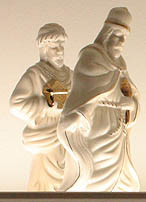 Today is Epiphany,
marking the end of the 12 Days of Christmas
(No. 12 was yesterday).
Today is Epiphany,
marking the end of the 12 Days of Christmas
(No. 12 was yesterday).
Epiphany commemorates the Wise Men's arrival to see Jesus
(probably not just 12 days after His birth),
but the actual origin of the holiday is somewhat
obscure.
And I am too busy to write much...it was a busy day, getting organized
for the new semester.
Happy Epiphany!

|
 |
2005
January
5
|
Odd weather and fake CPUs

Odd weather: No, Georgia is not normally this warm in January.
Ever since New Year's, we've been having spring-like weather, and there's no end
in sight. Normal would be a high of 45 and a low of 30; considerably colder
weather often occurs at this time of year.
Do I blame global warming? Not necessarily. Weather is inherently chaotic.
In the words of the late great ecologist, Eugene Odum,
"There is no normal weather."
Fake CPUs:
According to
news reports,
60,000 defective AMD CPUs (for personal computers) have been stolen and labeled
as if they were not defective.
Somebody's going to end up with a lot of PCs that don't work reliably.
This is actually a perennial problem in the semiconductor industry.
Because of the way ICs are made, each device has to be tested individually
before sale, and the yield of good ones is often as low as 50%.
The bad ones are not sold (or are relabeled as lower grades and sold more
cheaply, if they pass tests at a lower speed or narrower voltage range).
It's not uncommon for someone to buy up the duds very cheaply - the ones that
work at least partly, but are not up to specification - and relabel them to
look like new parts.
Or buy the lower-grade ones and relabel them as more desirable devices that
are somewhat similar.
This is what I call a crime of stupidity because the odds of getting
caught are relatively high. But people do it.

|
 |
2005
January
4
|
Monday night under the stars
Here's part of Monday night's bumper crop of astronomical photographs.
I'm still processing them; darkroom work is nowadays done on a computer,
but it still had to be done!
First, the season's first photograph of Saturn, taken by using my SBIG STV autoguider
as an imager:

Not very big, but not bad. This is a stack of 6 images, each of which was automatically
selected as the sharpest of dozens of frames. The telescope was my Meade 8-inch f/10
with a 2× Barlow lens. The images were processed with Registax.
Next, the curious nebula NGC 1999, a gas cloud that has a Y-shaped dark cloud
in front of it:

This is a stack of two images each of which was an in-camera stack of 3 one-minute
exposures at f/10.
Compare the Hubble image of the same nebula.
Here's a picture that clearly shows the tails of Comet Machholz.
The dust tail hangs down and the gas tail (ion tail) points to the left.

Why do the tails point in such different directions?
Actually, they point in nearly the same
direction, but we're looking at the comet almost head-on.
Point two of your fingers away from you, almost parallel, and look carefully.
You actually see a very wide, oblique angle between them.
And why do the stars look double?
Because this is a composite of four 3-minute exposures
with a 10-minute hiatus between the second and the third.
They are aligned on the comet, which moved so far during that interval
that each star is a pair of short streaks.
Last of all, my first attempt to attach the Digital Rebel to the telescope was very
successful. Here's the Orion Nebula in all its glory...well, as much of its glory as I've
ever managed to capture:

This is a composite of two 3-minute exposures with the 8-inch telescope, f/5.6 compressor lens,
and autoguider. The image was processed very carefully to preserve detail in the highlights.
From Russia with clicking noises
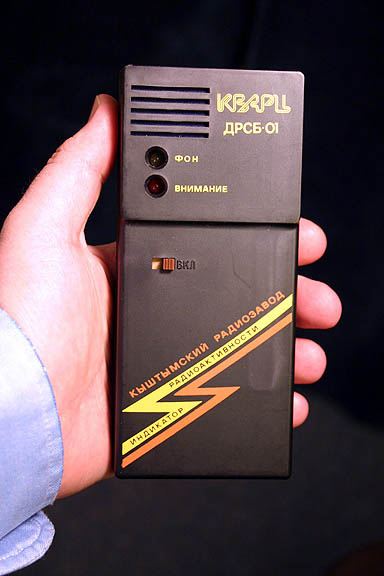
My latest electronic gadget is this Russian-made Geiger counter,
which I bought on eBay from Pavel Yelkin, who is selling them for only $20
(details here).
As you can see, the make and model are Kvarts DRSB-01
and it's a radioaktivnosti indikator, indicator of
radioactivity.
It is a true Geiger-Müller counter with a GM tube.
Many of the "Geiger counters" on eBay are actually ionization chambers.
It runs off two AA cells and has an audible clicker, as well as green
and red LEDs to indicate normal and abnormal levels of radiation.
"Normal" in Russia is higher than here, thanks to Chernobyl.
In America, the counter
often goes completely quiet for two or three seconds at a time.
Not back home.
It came with a Russian instruction leaflet and a rough English
translation; my first job was to get out the Russian dictionary and
render the instructions into somewhat better English.
By popular demand I've put my translated instructions on line
here. But I cannot answer any further
questions and in particular I cannot give advice about radiation safety.
Does it work? Yes, for gamma and beta rays, not alpha,
according to the specifications.
Did I find something radioactive on my workbench while trying
it out? Yes.
The radioactive object was a glass lens which I had been
using as a magnifier.
It's one of the internal elements from an old Pentax camera lens.
(A few years ago I bought, for $5, a set of five flood-damaged
Pentax lenses. I got two good lenses out of the set, so I figure
I came out ahead.)
High-index optical glass occasionally contains thorium.
Anyhow, it produces about 200 counts per minute - not dangerous,
but much higher than background radiation.
The counter doesn't detect radiation from the sources inside smoke detectors,
which are apparently quite well shielded.
See Chris Smolinski's web site
for more about radioactivity in daily life.
Reportedly, you can still get imported off-brand mantles for Coleman lanterns
that contain enough thorium to fog film.
Permanent link to this entry

|
 |
2005
January
3
|
Mystery revealed
Yesterday's mystery algorithm computes a sine curve.
Here is a plot of the first 100 values:

To understand why it computes a sine curve requires some thought.
Recall that yy and yyy are the previous and pre-previous values of y.
The crucial calculation is:
y = 1.9*yy - yyy
To see what's going on, break this up:
y = yy + 0.9*yy - yyy
Will y rise or fall relative to its previous value yy?
That depends on whether yyy is bigger than 0.9*yy.
Initially, of course, yyy is zero and y will increase fast,
but the increase
will slow down as yyy rises and more is subtracted out each time.
Eventually, yyy will rise until it exceeds 0.9*yy.
Then, more will be subtracted than added, and y will start down again.
This will continue until a similar crest is reached in negative values.
In effect, y has an upward force on it proportional to its previous value,
and a downward force proportional to its pre-previous value.
It has momentum, but also an effect tending to cancel the momentum to keep it from
going too far.
In short, y is a lot like numerous oscillating systems in nature,
such as bouncing springs and swinging pendulums.
I found this algorithm in a
Microchip application note (AN543)
that
shows how to use it to generate a sine wave
on a PIC microcontroller - provided you have floating-point arithmetic.
Last night was a very good night for astrophotography.
Pictures tomorrow.
It was warm and humid - about 50 F, 80% RH - and I was standing around in
only a light jacket, looking up at Orion.
It felt terribly out-of-season!

|
 |
2005
January
2
|
Mystery algorithm
Consider this algorithm:
yy = 0.0;
y = 1.0;
for (;;) // repeat as many times as you like
{
yyy = yy;
yy = y;
y = 1.9 * yy - yyy;
Console.WriteLine(y);
}
What does it compute? That is, what are the successive values of y?
The coefficient of 1.9 can actually be anything between,
but not including, 1.0 and 2.0.
Clearly, yy and yyy store previous values of y, and
this is some kind of signal processing algorithm.
It stretches out the initial sequence (0.0, 1.0) into something very interesting.
I'll give you the answer tomorrow.
Just to whet your appetite further, here is a signed 8-bit version with no multiplication,
suitable for use on very simple microprocessors. Here you see it written in C#, and >> is
the right-shift operator.
sbyte yyy;
sbyte yy = 0;
sbyte y = 64;
for (;;)
{
yyy = yy;
yy = y;
y = (sbyte)(yy + (yy >> 1) - yyy);
Console.WriteLine(y);
}
But what does it do?

|
 |
2005
January
1
|
How to divide centuries into decades
Happy new year!
Actually, I yelled "Happy new year!" at the dinner table at 7 p.m. local time,
which was midnight GMT. One might as well follow international standards...
We're now halfway through the first decade of the 2000s
(though not the first decade of the twenty-first century, which began in 2001).
And today I want to reflect on how we divide centuries up into decades:
the Fifties, the Sixties, the Seventies, and so forth.
My thesis is that we make the divisions on the basis of cultural changes,
not just the calendar.
Think about the Sixties for a moment.
Now think about 1962.
Chances are, 1962 doesn't fit your image of the Sixties nearly
as well as, say, 1971 does.
The cultural changes don't occur exactly on multiples of 10 years.
Looking backward a bit...
The 21st Century obviously began, for Americans, on September 11, 2001.
Many aspects of our life changed all at once on that day.
What about previous major transition, ushering in the Nineties?
There's no equally sharp event, but I think there's a cluster of them:
on the political front, the dissolution of the Soviet Union (December 1991),
and in popular culture, public access to the Internet (1993)
and the advent of the spam problem (1994).
Those events made the Nineties into what we remember.
Never mind that by this criterion, the Nineties lasted only about seven years.
Back to the Eighties...
Again, there were two defining events.
In politics and popular culture,
the somewhat unexpected landslide election of
Reagan
in 1980 was the turning point.
It changed the rules of politics; Reagan was criticized, not for tricking and outsmarting anyone,
but for actually keeping his campaign promises.
The economy underwent a sudden shift; inflation diminished (by fits and starts),
largely because people expected it to.
And popular culture shifted: pessimism was out and materialism was in.
The other defining event of the 1980s was the widespread adoption of Kaypro and IBM personal
computers in 1981 and 1982. For 1982 (I think), the personal computer was
Time Magazine's "machine of the year."
This may have had something to do with the shift in popular culture.
When you're dealing with computers, you can no longer pass off confusion as sophistication
(which was a major 1970s theme).
Either you make things work or you don't.
Computers introduced a healthy dose of objective reality into the popular Weltanschauung.
All right then, the Seventies.
I contend that they didn't actually begin until 1973-74
(end of the Vietnam War and resignation of Nixon).
They were a strangely deprived period; with no Vietnam War to protest,
people felt deprived of a cause.
I remember someone trying to get me to become an anti-draft activist in 1980,
at which time there was no draft and no compulsory registration...
exactly what was he wanting to get rid of, then?
In the Seventies it was fashionable to be confused.
How about the Sixties?
Again, I don't think they began on time.
Certainly, 1960 or even 1962 belong more to the previous decade than to their own.
I think the real transition was around 1963-64, with the assassination of Kennedy
(preceded by major foreign policy crises), the Vietnam build-up,
and, in popular culture, the Beatles' 1964 American TV debut, followed by a sudden
and radical change in the role of popular music in society.
The beginning of the Fifties is harder to pinpoint.
There was certainly no major political change at the time.
We think of the Fifties as a time of prosperity, optimism, and lively but
silly and conformistic popular culture.
I think what ushered in the Fifties was television, and it reached different
parts of the country at different times.
Georgia got its first TV station in 1948;
rural south Georgia, where my parents lived,
got TV around 1954.
And when it arrived, the impact of TV on people's lives was powerful.
So the Fifties had a vague beginning.
Not so the Forties, which started on December 7, 1941.
Nor the Thirties, which obviously began with the 1929 stock market crash.
American history before that is harder to carve up into decades,
and indeed, the very ability to carve it up depends on mass communications
which tend to impose changes everywhere at the same time.
And all of this applies only to the United States, of course.
Other countries have different divisions, or none at all.
When in England in the 1970s I was struck by the lack of perceived
discontinuity between the Seventies, Sixties, and Fifties.
The borders just weren't as sharp.
On the other hand, the beginning of the Thatcher Era was a
dramatic change.
Odd radios I have known
For a while in the early 1980s I owned
a
Bearcat DX-1000, one of the first
digitally tuned shortwave radios.
If you've ever tuned a shortwave radio that wasn't digital,
you'll understand that despite its mediocre performance, the Bearcat was a
delight to use.
But its user interface was one of the worst I've ever seen.
Look carefully at
this picture.
Two different buttons, unrelated and not adjacent,
are both labeled CLEAR!
Fortunately you could listen to the radio without pressing either one.
The biggest design flaw in the DX-1000 is that one of the capacitors in
the audio output stage is a factor of 10 too small
(maybe 10 uF instead of 100 uF; I don't remember).
This gave the radio a very tinny sound.
I changed mine, and then it almost sounded normal.
But my
Sony ICF-2010,
purchased in 1987 and still going strong, is much better.
I've modified it by replacing the "narrow" filter with an alternative "wide" one,
not as wide as the "wide" filter that came with it
(cf. WD8DAS' notes).
I'm going to add a 1-farad capacitor so that it doesn't lose its memories when
changing the backup batteries.
I figure I'll have this radio perfect right around the time international
shortwave broadcasting becomes completely obsolete!
How long will latex paint keep? I just touched up a spot on the wall of my
darkroom using some of the original paint, which is now 14 years old.
It had been kept in a glass jar full to the brim.
Getting the lid off took a bit of prying, followed by the use of
two strap wrenches, but the paint needed only a little stirring and
then it was fine.
The paint was Glidden "Wash & Wear" or something of the sort,
a semigloss designed for bathrooms and children's rooms.

|
Smile?
If someone can tell me why this particular
word was printed in this particular place,
then we'll both know!
|

|
 |
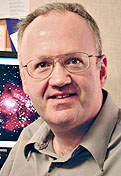

![]()
 This morning [Jan. 29], all the pavement in town now has a centimeter of ice on it, and
people are being encouraged to stay home.
Most of the roads are barely usable, and there's more ice coming tonight.
Fortunately, there have not been extensive power outages.
This morning [Jan. 29], all the pavement in town now has a centimeter of ice on it, and
people are being encouraged to stay home.
Most of the roads are barely usable, and there's more ice coming tonight.
Fortunately, there have not been extensive power outages.
 Candlelight:
At 8:10 p.m. our electricity failed, and a quick listen to the scanner radio told me
that ice-laden trees were falling on power lines all over town.
We settled in for the duration.
I'm writing a blog entry by candlelight, just like they did back in the 1800s
(just kidding!).
Actually I am using the laptop on battery power.
Candlelight:
At 8:10 p.m. our electricity failed, and a quick listen to the scanner radio told me
that ice-laden trees were falling on power lines all over town.
We settled in for the duration.
I'm writing a blog entry by candlelight, just like they did back in the 1800s
(just kidding!).
Actually I am using the laptop on battery power.
 Now Cathy has a dog of her own, alongside Melody's dog Babbage,
and the two dogs are doing a marvelous job of entertaining and
even training each other.
Now Cathy has a dog of her own, alongside Melody's dog Babbage,
and the two dogs are doing a marvelous job of entertaining and
even training each other.
 So much for the
So much for the  The unassuming object at the right is a 50-year-old transistor.
Specifically, it is a Sylvania type 2N34 germanium PNP transistor dating
from the mid-1950s.
But its main claim to fame is that it belonged to the late Louis E. Garner, Jr.,, who
for 20 years or more was semiconductor specialist for Popular Electronics.
I saw part of Garner's estate on eBay and made contact with the seller;
I'm going to help him identify gadgets.
The unassuming object at the right is a 50-year-old transistor.
Specifically, it is a Sylvania type 2N34 germanium PNP transistor dating
from the mid-1950s.
But its main claim to fame is that it belonged to the late Louis E. Garner, Jr.,, who
for 20 years or more was semiconductor specialist for Popular Electronics.
I saw part of Garner's estate on eBay and made contact with the seller;
I'm going to help him identify gadgets.



 Consider again yesterday's picture of how to open the battery pack.
This is in fact a mundane example of something the great art critic
E. H. Gombrich somewhere wrote about:
how to show the passage of time in a still picture.
Consider again yesterday's picture of how to open the battery pack.
This is in fact a mundane example of something the great art critic
E. H. Gombrich somewhere wrote about:
how to show the passage of time in a still picture.
 This afternoon I had some trouble with the batteries running down prematurely in my
rechargeable
This afternoon I had some trouble with the batteries running down prematurely in my
rechargeable 


 One of the relatively few possessions I still have from before my father's death (October 1966) is
a blue fluorescent desk lamp which I persuaded him to buy for me at Woolworth's for $4.95.
I think it dates from the end of 1965, when we were moving into a new house and
buying lots of home furnishings.
One of the relatively few possessions I still have from before my father's death (October 1966) is
a blue fluorescent desk lamp which I persuaded him to buy for me at Woolworth's for $4.95.
I think it dates from the end of 1965, when we were moving into a new house and
buying lots of home furnishings.
 Traditionally, the way we try out electronic circuits is to plug the components
into a
Traditionally, the way we try out electronic circuits is to plug the components
into a

 Today is
Today is 






